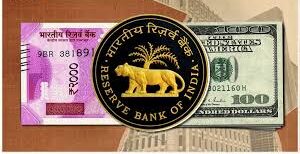RBI’s Record Forex Intervention in November 2024
Overview of RBI’s Record Forex Intervention in November 2024
In November 2024, the Reserve Bank of India (RBI) made headlines with its record-breaking foreign exchange (forex) intervention, marking a significant step in stabilizing India’s foreign exchange reserves. The central bank’s decision to intervene in the forex market became essential as it sought to protect the rupee’s value and ensure financial stability amidst global uncertainties.
RBI’s Strategy and the Amount Involved in the Intervention
The RBI’s intervention involved a substantial amount of resources, as it sought to moderate excessive volatility in the Indian rupee. During this period, the central bank reportedly spent a record $10.2 billion, the highest in a single month in the past five years. This amount was directed at curbing the rapid depreciation of the Indian rupee against major currencies, especially the US dollar.
The forex intervention strategy primarily focused on buying and selling the US dollar in the open market to ensure that there was adequate liquidity in the system while avoiding sharp fluctuations in the rupee’s value. Such proactive steps by the RBI are critical for maintaining investor confidence and ensuring price stability in the economy.

Why This News Is Important
The intervention is particularly crucial as it highlights the RBI’s role in ensuring economic stability in the face of external shocks. The global economy has faced several challenges, including inflationary pressures, geopolitical tensions, and rising commodity prices. These factors can often affect emerging economies like India, making their currencies vulnerable to sharp fluctuations. The RBI’s action is significant as it emphasizes the importance of safeguarding India’s currency value, which directly influences inflation, imports, and overall economic growth.
Furthermore, this intervention impacts various sectors, including trade, finance, and foreign investments. A stable currency aids in the predictability of costs and investments, which is essential for India’s long-term growth strategy.
Impact of RBI’s Forex Intervention on the Indian Economy
RBI’s forex intervention plays a crucial role in managing inflation and protecting the value of the rupee. By increasing its foreign currency reserves, the central bank ensures that India can maintain its import obligations without facing a balance of payments crisis. A stable currency helps mitigate the inflationary pressures caused by expensive imports, such as oil, which significantly affects the domestic economy.
In the short term, such interventions help ease the burden on consumers and businesses by avoiding steep hikes in the cost of goods and services. Moreover, by providing a buffer against exchange rate volatility, the RBI ensures that foreign investors have confidence in India’s financial system, contributing to sustained investment and capital inflow.
Historical Context
RBI and Forex Management: A Historical Perspective
The Reserve Bank of India has a long history of intervening in the forex market to stabilize the rupee. The central bank’s role in managing India’s foreign exchange reserves dates back to its establishment in 1935. Over the years, the RBI has navigated various challenges, such as the 1991 balance of payments crisis, which led to a shift in India’s economic policies and the liberalization of the foreign exchange market.
In recent years, RBI’s interventions have become more systematic, with a focus on managing both the volatility of the rupee and the stability of the country’s foreign reserves. The 2024 intervention marks the latest chapter in this ongoing effort, where the RBI has leveraged its forex reserves to safeguard India’s economic stability.
Historically, the RBI has faced numerous challenges, including fluctuations in global oil prices and changes in foreign investment flows, which impact the rupee. However, the central bank’s proactive measures have ensured that India’s economy remains resilient, even during times of global economic instability.
Key Takeaways from RBI’s Record Forex Intervention
| S.No. | Key Takeaway |
|---|---|
| 1 | The RBI spent a record $10.2 billion on forex intervention in November 2024. |
| 2 | The intervention aimed at stabilizing the rupee amid global economic uncertainty. |
| 3 | The RBI’s actions help maintain India’s import obligations and control inflation. |
| 4 | A stable rupee boosts investor confidence and strengthens foreign capital inflows. |
| 5 | This intervention underscores RBI’s role in safeguarding India’s economic stability. |
Important FAQs for Students from this News
1. What is the significance of RBI’s forex intervention in November 2024?
- The RBI’s forex intervention in November 2024 was crucial for stabilizing the Indian rupee against the US dollar. The central bank spent a record $10.2 billion to ensure the rupee’s stability amidst global economic challenges, including rising inflation and geopolitical uncertainties.
2. How does RBI intervene in the forex market?
- The RBI intervenes in the forex market by buying or selling foreign currencies, primarily the US dollar, to influence the exchange rate. This helps in controlling the rupee’s value, preventing excessive depreciation or appreciation.
3. Why is a stable rupee important for India’s economy?
- A stable rupee ensures the predictability of import costs, especially for crucial goods like crude oil, and helps control inflation. It also boosts investor confidence, making India an attractive destination for foreign investments, which contributes to economic growth.
4. How does RBI’s intervention impact inflation?
- By stabilizing the rupee, RBI’s intervention prevents sharp increases in the cost of imports, which could lead to inflation. It helps in maintaining the purchasing power of consumers and keeps the economy from overheating.
5. What is the historical role of the RBI in managing India’s forex reserves?
- The RBI has played a critical role in managing India’s forex reserves since its establishment in 1935. Over the years, it has intervened in the forex market to stabilize the rupee, especially during times of global economic crises such as the 1991 balance of payments crisis.
Some Important Current Affairs Links


















